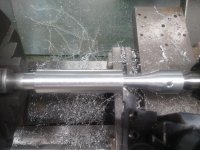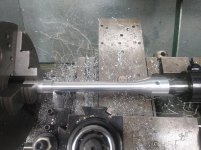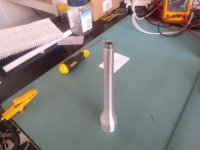Haven't posted here for a while, this project is not dead just delayed with jobs for other people. I'm also not happy with the current rail, it has way too much play rocking back and forth, so I've been doing research on different rail/carriage assemblies.
The rail needs to quiet with zero play. Mini V wheel and V rails used by 3D printers could be a good solution on a 20x20 rail.
Universal Aluminum Gantry Plate 20-80mm Durable V Slot 3D Printer Linear Rail | eBay
I have done some upgrades to my current EPA100 that have provided a great deal of experience in the effects of controlling vibration in the arm assembly, especially in the mounting. Changing the mount from the stock item to a rigidly coupled collet style improved the sound. This got me thinking that the current rail is inadequate.
I have also been thinking about the arm wand. I have looked at the designs of the SME V and the SAT CF1. Both employ rigidity as a main design criterion. I have 4x Vee jewels for both vertical and horizontal pivots, pins will be made from HSS drills.
Arm wand will be machined from 7075 T6 aluminium. The plan is to machine a tapered arm wand with a 1mm wall section. 200mm P2S. There will be internal damping as well as bracing either carbon fiber or aluminium.
Headshell collet will be an SME style and press fit into the arm wand.
Let's see how long it takes me to get to the next stage.....
The rail needs to quiet with zero play. Mini V wheel and V rails used by 3D printers could be a good solution on a 20x20 rail.
Universal Aluminum Gantry Plate 20-80mm Durable V Slot 3D Printer Linear Rail | eBay
I have done some upgrades to my current EPA100 that have provided a great deal of experience in the effects of controlling vibration in the arm assembly, especially in the mounting. Changing the mount from the stock item to a rigidly coupled collet style improved the sound. This got me thinking that the current rail is inadequate.
I have also been thinking about the arm wand. I have looked at the designs of the SME V and the SAT CF1. Both employ rigidity as a main design criterion. I have 4x Vee jewels for both vertical and horizontal pivots, pins will be made from HSS drills.
Arm wand will be machined from 7075 T6 aluminium. The plan is to machine a tapered arm wand with a 1mm wall section. 200mm P2S. There will be internal damping as well as bracing either carbon fiber or aluminium.
Headshell collet will be an SME style and press fit into the arm wand.
Let's see how long it takes me to get to the next stage.....
Attachments
I did evaluate CF, but I want to use a tapered arm wand. If I use a pool cue then it needs to be glued to the bearing assembly. The issue with this is the glue joint will have a different acoustic impedance to the CF and reflect vibration energy back to the cartridge. I tried to source pre-preg CF to make my own wand with no success here in Aus.
Using the same material for the entire arm wand from headshell end to CW stub IMO is the best way to proceed. This is why I chose 7075 aluminium. I can machine the internal and external tapers slightly different so the wall thickness varies from end to end.
Before I machine the 7075 I will make a prototype from 6061. I suspect the SME V is made from 7075 T6 it has very high tensile strength similar to steel with the mass of aluminium.
This project is about building the very best servo linear tracking arm possible.
Using the same material for the entire arm wand from headshell end to CW stub IMO is the best way to proceed. This is why I chose 7075 aluminium. I can machine the internal and external tapers slightly different so the wall thickness varies from end to end.
Before I machine the 7075 I will make a prototype from 6061. I suspect the SME V is made from 7075 T6 it has very high tensile strength similar to steel with the mass of aluminium.
This project is about building the very best servo linear tracking arm possible.
The problem is 7075 T6 aluminium tube is not available,
Hi warrjon,
McMaster-Carr in the US has 2024 Aluminum tubing. It's a close relative of 7075.
Sincerely,
Ralf
Hi Ralf, shipping from the US to Aus is around $85 + the cost of the tube.
I can buy 7075 T6 round bar locally. I have the machining capability so I can also make the wall thickness vary over the taper.
I plan to start machining the prototype on Monday, after I have finished a platter for another member.
I can buy 7075 T6 round bar locally. I have the machining capability so I can also make the wall thickness vary over the taper.
I plan to start machining the prototype on Monday, after I have finished a platter for another member.
I know using off the shelf CF or aluminium tube would make fabrication of the arm wand easier. My decision to machine the wand from a billet of aluminium is to have no joins in the wand, glue joints however good provide a reflection point for vibration traveling down the arm.
An arm made from a single billet has no reflection points so almost all of the vibration energy will travel down the arm to the bearing before some is reflected back to the cartridge. The heavy variable taper will prevent vibrations being reflected directly back they will bounce around in the arm so what energy does return to the cartridge will be attenuated.
This arm will have the headshell and arm wand machined as a single structure. The arm wand is 30mm OD at the bearing housing and 12mm at the headshell.
I have ordered the V rail and 6061 for the prototype arm wand.
An arm made from a single billet has no reflection points so almost all of the vibration energy will travel down the arm to the bearing before some is reflected back to the cartridge. The heavy variable taper will prevent vibrations being reflected directly back they will bounce around in the arm so what energy does return to the cartridge will be attenuated.
This arm will have the headshell and arm wand machined as a single structure. The arm wand is 30mm OD at the bearing housing and 12mm at the headshell.
I have ordered the V rail and 6061 for the prototype arm wand.
Attachments
It seems like a very interesting project.
If I were you, I may choose a .75" filament-wound carbon tube as the wand and 7075 or 2024, (I always prefer 2024, never tried 7075) aluminum as the headshell. In my opinion, it is better to use 2024 aluminum or titanium for anything which touches the cartridge. Since the weight is not an issue, I would prefer to use a heavy-duty carbon fiber tube as long as the correct effective mass allows. I also like to use aluminum for the bearing parts. Personally, I prefer 4 points bearing as SAT or Kuzma 4 points bearings. In other words, it is basically a servo-driven pivot arm. I personally prefer a mixture of different materials.
I don't know how do you deal with the starting point of the arm and the ending point of the arm. It seems to me it requires some programming.
Carbon fiber tube link
Tube - Filament Wound - Unsanded - 0.500 x ~0.780 x 12 Inch - Sold by the foot - Available up to 96 Inches
If I were you, I may choose a .75" filament-wound carbon tube as the wand and 7075 or 2024, (I always prefer 2024, never tried 7075) aluminum as the headshell. In my opinion, it is better to use 2024 aluminum or titanium for anything which touches the cartridge. Since the weight is not an issue, I would prefer to use a heavy-duty carbon fiber tube as long as the correct effective mass allows. I also like to use aluminum for the bearing parts. Personally, I prefer 4 points bearing as SAT or Kuzma 4 points bearings. In other words, it is basically a servo-driven pivot arm. I personally prefer a mixture of different materials.
I don't know how do you deal with the starting point of the arm and the ending point of the arm. It seems to me it requires some programming.
Carbon fiber tube link
Tube - Filament Wound - Unsanded - 0.500 x ~0.780 x 12 Inch - Sold by the foot - Available up to 96 Inches
Last edited:
The issue with using 7075 for heashell and CF tube is the joint. Speed of sound in Al is double CF so most of the energy will be reflected back to the cartridge.
Bearings will be 4 point. I already have 4x jewel Vee's for the bearing. The bearing housing will be 6060 T5 as this is all I could get in the required size. Remember I'm in Australia and shipping from the USA is expensive.
This arm is a servo driven pivoting arm controlled by a photo sensor and an Arduino. The servo part is already operational and totally automated. Push a button and the arm goes to the start of the LP and cues down, the carriage is programmed too slow to keep up with the arm at the runout groove and triggers the cue motor exactly like the Rabco.
The code is written to step the motor 3 steps at a time with 1/16 micro stepping so the carriage moves an incredibly small amount with each step sequence. I can't remember off the top of my head the exact mm but it's less the 0.5mm per step sequence and this can be changed easily in the code. I wrote the code so all variables are in 1 block making adjusting variables easy.
The code also has high speed return and high speed left and right traverse.
Bearings will be 4 point. I already have 4x jewel Vee's for the bearing. The bearing housing will be 6060 T5 as this is all I could get in the required size. Remember I'm in Australia and shipping from the USA is expensive.
This arm is a servo driven pivoting arm controlled by a photo sensor and an Arduino. The servo part is already operational and totally automated. Push a button and the arm goes to the start of the LP and cues down, the carriage is programmed too slow to keep up with the arm at the runout groove and triggers the cue motor exactly like the Rabco.
The code is written to step the motor 3 steps at a time with 1/16 micro stepping so the carriage moves an incredibly small amount with each step sequence. I can't remember off the top of my head the exact mm but it's less the 0.5mm per step sequence and this can be changed easily in the code. I wrote the code so all variables are in 1 block making adjusting variables easy.
The code also has high speed return and high speed left and right traverse.
warrjon said:The code also has high speed return and high speed left and right traverse.
Hi warrjon,
It would be cute if you just called it "Fast Forward and Rewind" because that is what it really is.
Just a thought.
Sincerely,
Ralf
Hi warrjon,
It would be cute if you just called it "Fast Forward and Rewind" because that is what it really is.
Just a thought.
Sincerely,
Ralf
This forum needs a like button...........
Hi warrjon,
It is indeed an excellent project after I learned more about your DIY servo-driven arm.
This all came about after a lot of research and thought on how a tonearm needs react. Basically it needs to have 4 degrees of freedom only and be totally neutral with no overt behavior and there are very few arms that meet this criteria, even the SME V has the stylus offset from the center of the arm wand, which will have an effect on its ellipsoid of inertia. The SAT is probably one of the few that conforms to the physics as it was designed as a precision measuring instrument in the words of Marc Gomez.
This project is not about building a good arm, it's goal is to build the very best arm possible with the materials I have available. I would have made the arm wand from CF pre-preg but can't get it except in commercial qty's so 7075 T6 aluminum is the next best material.
Having a variable taper in the arm wand greatly reduces reflected vibrational energy traveling back to the headshell. So it's important to have as few joins in the wand as possible.
Just thought I'd post pics of the arm wand I finished machining today. The bearing end is 30mm OD with a variable taper for 40mm then 1deg straight taper to the headshell.
Next on the list is the bearing assembly. I have 4 sapphire Vee jewels for the vertical and horizontal pivots.
Next on the list is the bearing assembly. I have 4 sapphire Vee jewels for the vertical and horizontal pivots.
Attachments
So is there a specific concept/servo you have in mind to compensate for eccentricity? Short of Nakamichi's Dragon solution I don't see how. The higher the complexity, the poorer the resolution becomes. That's why the Nak doesn't compensate, it eliminates it first.I have been experimenting with LT tonearms over the past 6-8 months, and have built 2 different LTA's with 4 different carriages. During this process I have learnt that a short stiff carriage/armwand is what is needed.
LTA 1 - Built as a proof of concept. This was about as good as my reference arm a Technics EPA100. Bass response was better and noise floor slightly lower. It struggled with stock bearings to track the Stanton 881s so I increased the diameter of the wheels which made a huge difference. Changed to my Technics EPC205mk2 with a Jico SAS.
LTA 2 - This is a total rip off of the Clear Audio TT1 and Niffy's carriage (the FROG). What this does amazingly is lower LP surface noise to levels I have never experienced, detail and dynamics are fabulous. Its issue is tracking off centre pressings where the voice has a lot of energy, I can hear distortion in each channel as the carriage moves back and forth. I built another carriage this time 20g lighter. This new carriage still has distortion on very heavily modulated tracks on the test LP, but I haven't heard it on music yet. It sounds great, but does have higher surface noise.
The reason I started this thread is I am considering building a motor driven LTA and I'm looking for others thoughts and ideas.
Goal is to duplicate LTA 2's FROG performance without the distortion tracking off centre pressings. Is this even possible
First decision is either mechanical servo like the Rabco or use an Adrino robotic controller?
Arm will be split effective mass like the Dynavector DV505. Main arm to be large and rigid with horizontal bearing and secondary arm on the end with vertical pivot.
Technics SL1200 bearings can be used for both pivots.
Carriage will run on 2x 8m linear rails in brass/bronze bushes.
Drive will be toothed belt driven by O rings
Drive motor 12V geared run at lower voltage to keep noise low
- Home
- Source & Line
- Analogue Source
- DIY Servo driven Linear tonearm



